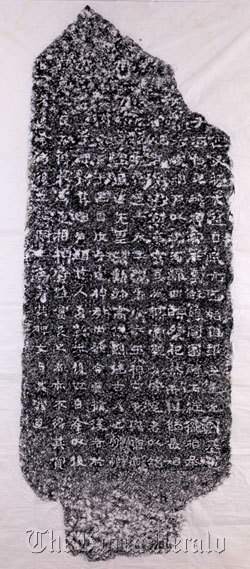A stone monument from the ancient Korean kingdom of Goguryeo has recently been discovered in Jian, northeastern China, in what could be “a major archaeological landmark,” a South Korean historian said, quoting a Chinese state newspaper.
Goguryeo controlled the northern half of the Korean Peninsula and northeastern China for more than 700 years until A.D. 668.
Goguryeo controlled the northern half of the Korean Peninsula and northeastern China for more than 700 years until A.D. 668.

“The Chinese Cultural Relics News published by China’s State Administration carried the news of the discovery of a Goguryeo monument in an article dated Jan. 4,” Yeo Ho-gyu, a history professor of the Hankuk University of Foreign Studies, told Yonhap News Agency by phone. The third extant Goguryeo stele, if confirmed, would be a “landmark discovery in the history of local archaeological study,” said the professor who serves as an executive member of the private Society for Korean Ancient History.
According to the report, a Jian resident first discovered the new monument near a river on July 29 and reported it to the local cultural heritage authority.
The authority confirmed it as a Goguryeo monument after an on-site survey by a team of experts, it said.
Only two Goguryeo steles have so far been found ― one is the famous tombstone of King Gwanggaeto also unearthed in Jian in the 19th century and the other is Goguryeo Stele of Chungju found in South Korea in the late 1970s. The second one, better known as Goguryeo Stele of Jungwon, is one of the country’s national treasures.
Both are known to have been erected by King Jangsu (394-491) in the 5th century to honor his late father who is remembered as one of the greatest conquerors in Korean history for expanding the territory of Goguryeo to northeastern China.
Yeo and other historians say the third one is also believed to have been built by King Jangsu to display rules for managing other royal tombs, a purpose similar to that of the Stele of King Gwanggaeto.
Yoon Yong-goo, an expert at Incheon Metropolitan City Museum, says that the new one can be called “a miniature” of the one found earlier in the area, which is bigger and contains more general guidance.
The monument, according to the report, is 173 centimeters high and 60.6-66.5 centimeters wide and weighs 464.5 kilograms, while the Stele of King Gwanggaeto is 639 centimeters high.
The report also said the new one had 218 Chinese letters inscribed on it, with only 140 of them recognizable.
(Yonhap News)
-
Articles by Korea Herald



![[AtoZ into Korean mind] Humor in Korea: Navigating the line between what's funny and not](http://res.heraldm.com/phpwas/restmb_idxmake.php?idx=644&simg=/content/image/2024/04/22/20240422050642_0.jpg&u=)


![[Exclusive] Korean military set to ban iPhones over 'security' concerns](http://res.heraldm.com/phpwas/restmb_idxmake.php?idx=644&simg=/content/image/2024/04/23/20240423050599_0.jpg&u=20240423183955)
![[Herald Interview] Why Toss invited hackers to penetrate its system](http://res.heraldm.com/phpwas/restmb_idxmake.php?idx=644&simg=/content/image/2024/04/22/20240422050569_0.jpg&u=20240422150649)
![[Graphic News] 77% of young Koreans still financially dependent](http://res.heraldm.com/phpwas/restmb_idxmake.php?idx=644&simg=/content/image/2024/04/22/20240422050762_0.gif&u=)







![[Exclusive] Korean military to ban iPhones over security issues](http://res.heraldm.com/phpwas/restmb_idxmake.php?idx=652&simg=/content/image/2024/04/23/20240423050599_0.jpg&u=20240423183955)



![[Today’s K-pop] Ateez confirms US tour details](http://res.heraldm.com/phpwas/restmb_idxmake.php?idx=642&simg=/content/image/2024/04/23/20240423050700_0.jpg&u=)